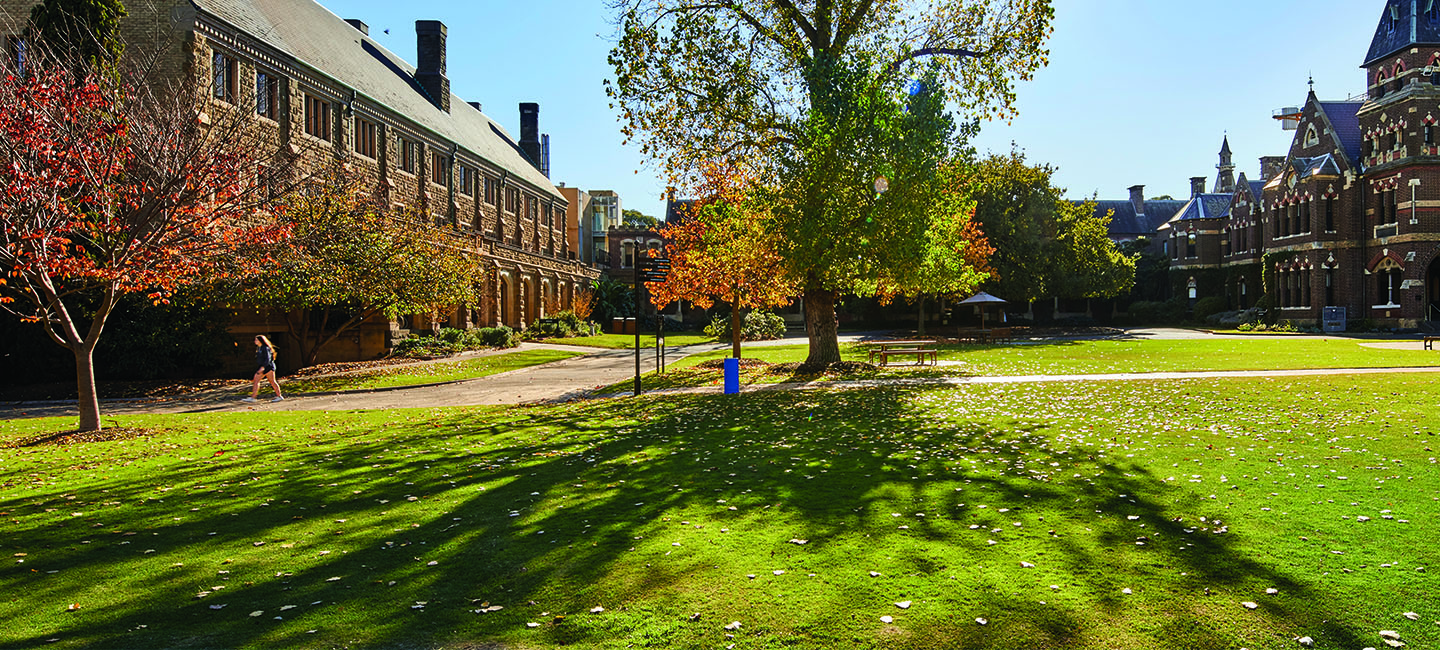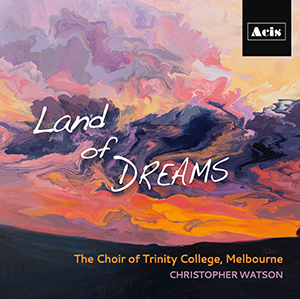

One hundred years ago yesterday, on Saturday 24 November 1917, members of Trinity College, members of the Diocese of Melbourne and members of the University of Melbourne gathered here for the Consecration of what was, rightly, hailed as ‘this noble Chapel’.
From 1878 the less ample spaces of the temporary Chapel in the Warden’s Lodge had witnessed the devotions of Trinity students.
The distinctive effect of the Consecration was that the most conspicuous building of the College was now a building solemnly dedicated in the Name of the Holy Trinity. Publicly and emphatically, it proclaimed Trinity’s motto, Pro Ecclesia, Pro Patria.
For the College it was undoubtedly the best of times seeing the conjunction of the three forces that created this monumental edifice, namely Alexander Leeper, the veteran Warden whose vision of a worthy Chapel for his College never failed, Alexander North, the Launceston architect who had already demonstrated his understanding and mastery of the principles of the Arts and Crafts Movement, and John Sutcliffe Horsfall, the Yorkshire migrant whose business success in his adopted country had provided the means to bring the desired outcome to fruition.
But the best of times were soon to be succeeded by the worst of times. Leeper’s overblown appeals for enlistment almost emptied his College; runaway wartime inflation bankrupted the College’s builder; and Horsfall’s death in 1916 deprived the Chapel of its promised organ. So, at its opening, the woodwork with its distinctive Australian motifs was incomplete, there was no electric light and the organ came only in 1923. As well, the College was without a resident Chaplain.
In retrospect, the arrival of Thos. Robinson as Chaplain in 1927 was pivotal. From the first he sought, with some success, to raise the standard of worship in the Chapel, teaching new hymn tunes and introducing Compline as a late sung service. Servers were trained and enrolled in a Guild of the Sanctuary, which soon included a large and representative group of residents. His custom of inviting men to supper to discuss problems in the relationship of religion, science and philosophy grew in popularity and morphed into The Rusden Club. When he left after seven years, his chaplaincy had effected a significant change in the students and their attitude to the Chapel.
Thankfully, the improvement in Chapel music was sustained under the leadership of professional musicians such as William McKie and Howard Hollis and keen staff members such as AGL Shaw.
My first glimpse of the Chapel as a University Fresher in 1950, evoked more curiosity than anything else. What was it? It wasn’t Gothic as I knew it; it was too heavy for that. I hadn’t been to Launceston and was ignorant of the Arts and Crafts Movement. In the years since, I have come to appreciate it more and more, assisted by Dr Miley’s splendid study of this Chapel. But there was a problem. In the days before Cowan was built, when cows still grazed up to its walls, it looked distinctly forlorn and unloved. Only later did I learn that its placing derived from one of the several Master Plans for the College that were never implemented.
These were the days of compulsory chapel and I would have to acknowledge that only the disincentive of a fine for non-attendance ensured a certain familiarity with it on the part of the resident students. However, there were benefits from this compulsion. Veteran councillors like Sir Edmund Herring might regularly expatiate on the benefits of early rising: students saw more point, especially in the first weeks of term, in inspecting the freshers seated opposite. Not infrequently, the outcome was a post-graduate voluntary return for the nuptials. Theologs excepted, the only other occasions that saw voluntary attendance were compline (especially at exam times) and the Valedictory Service.
While Barry Marshall’s ministry ensured that there was no sudden collapse of chapel-going following the abolition of compulsory chapel, the ‘sixties did see the emergence of a Chapel Community broader than the College and, to some extent, differentiated from it. The focus of the Canterbury Fellowship, a tenant of the Chapel from 1957, was unashamedly musical, but its Chaplain was also an Anglican presence within the University and in South Parkville.
As it has emerged and developed, the Chapel Community has functioned within the College as a special interest group, but one, which is basically other-regarding rather than self-regarding. So, it pioneered co-education with Chapel Breakfasts at Trinity and J.C.H. and innovative programs in outreach and community service. The Choral Foundation enables student musicians to enjoy the unique experience of learning and singing in the highly esteemed Trinity College Choir.
From the opening of the Chapel, a considerable responsibility rested with the resident Theologs, (rarely numbering more than a dozen). Apart from Sundays, when they dispersed to parish placements, they ensured a nucleus of worshippers at the morning and evening services. However, by the ‘eighties, a majority of the members of the Theological School were non-resident and mature-age. Only with difficulty were services maintained. In response, a weekly Chapel service had to be arranged at a time that was convenient for the majority.
When I attended my first Cathedral Deans’ Conference, I was intrigued by references to GOH Services. It didn’t take long to work out that this stood for Gate of Heaven Services. (Shades of Jacob’s dream at Bethel!) I have arranged and attended many such, celebrations of both the living and the departed. They have been not only for particular families and groups but also in times of natural and man-made disasters. Thus, many of you have contributed to this community’s grieving, not least at the passing of those great souls, Arthur Hills and Frank Henagan.
Externally, this Chapel today, following its splendid restoration by Robert Cripps and members of his family, stands foursquare against the elements that once threatened to destroy it. Likewise, internally, apart from the Organ, there has been no permanent change in the arrangements of the Chapel. They have proved remarkably flexible in accommodating the needs and aspirations of successive generations by providing a range of liturgical spaces.
This Chapel and the community it serves have known highs and lows over its first Century. I do not presume to assess its present position. What sustains me, and I hope all of you, is the conviction, based on our experience, that our God is a God of Surprises. There is still more light and truth to come. We haven’t heard it all before. And we should expect to be surprised here, as much, perhaps more, than anywhere.
In my sixty-year association with this College and its Chapel, I have heard many notable addresses. In 1995, Dr Davis McCaughey, the former Master of Ormond, spent some time in College as the First Woods Fellow. Amongst other notable contributions to its life, he gave one such on the topic “Professionals in the 21st Century”. Its theme, stated briefly, was that if the voices of reason and conscience do not continue to be raised insistently, to challenge a world where only greed and self-aggrandisement count, where the professions have lost their consciences and the decent world seems to be crumbling around us, then desolation will surely descend. Voices of reason and conscience. My concluding prayer is, may they long continue to be heard in this Chapel as it begins its second Century.
The Lord be with you.
+James Grant
Related News
-
News & Stories
- Our Theological School Student President's mission to champion a spiritual and welcoming environment
- Jack reaps the rewards after taking a leap of faith on Trinity College
- Trinity alum named in King's Birthday Honours 2025
- Trinity Deputy & Academic Dean appointed Fellow at Center of Theological Inquiry
- Meet Trinity's aspiring art curator Seb Moore
- Trinity College offers its congratulations to newly elected Archbishop of Melbourne, the Right Reve
- Events
- Art
- Music & Choir
- Campus Development Projects
- Visiting Scholars & Lectureships
- Accommodation for Visitors
- Short Programs
- Work at Trinity

